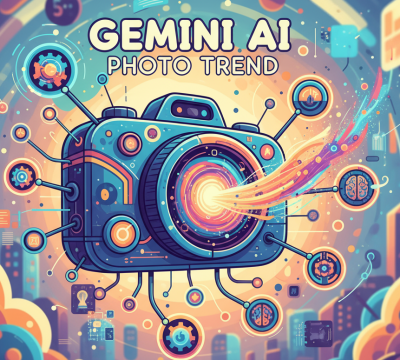If you’ve scrolled through social media recently, you’ve probably noticed friends, influencers, or even corporate brands posting AI-generated headshots that look stylish, futuristic, and strangely real. This viral movement, now widely known as the Gemini AI photo trend, has taken over Instagram, LinkedIn, and forums alike. But beyond the artistry and novelty, there lies a deeper conversation: what are the security and business implications of this new wave of AI-powered image creation?
This blog explores the rise of the Gemini AI photo trend, why it matters for industry leaders, and what cybersecurity professionals must understand to protect digital identity in an era where pixels can no longer be trusted.
What is the Gemini AI Photo Trend?
The Gemini AI photo trend refers to the viral phenomenon of users generating lifelike portraits of themselves using Google’s Gemini AI system. These portraits are hyper-realistic, stylized, and often indistinguishable from authentic photography.
The trend picked up momentum when users on TikTok and Instagram began posting AI-stylized versions of themselves, ranging from cinematic avatars to corporate-style professional headshots. What initially felt like an innocent “photo filter” moment soon morphed into a global cultural wave.
Why did it go viral? Three main reasons:
- Accessibility: Apps powered by Gemini AI made the process seamless.
- Aesthetic appeal: The portraits were better than selfies, often making users look “idealized.”
- Social validation loop: People shared because others shared—leading to exponential virality.
But like most AI trends, what begins as harmless fun quickly attracts attention from malicious actors.
Why the Gemini AI Photo Trend Matters for Businesses
It’s tempting to dismiss visual AI trends as internet fads. However, enterprises must recognize their deeper implications:
- Brand Identity: If AI can convincingly replicate executives’ images, your brand reputation may be at risk.
- Recruitment & Networking: AI-generated photos are now surfacing on LinkedIn, leaving HR teams vulnerable to fraudulent accounts.
- Digital Footprint Inflation: Executives and celebrities find themselves “re-presented” online in ways they cannot control.
A striking example occurred when a fake AI-generated “founder portrait” of a startup began circulating in investor forums. It fooled hundreds until deeper scrutiny revealed it was entirely synthetic. This shows how Gemini AI images can weaponize digital trust—a core concern for CEOs and cybersecurity experts alike.
Security Risks Behind the Gemini AI Photo Trend
The Gemini AI photo trend introduces a new attack surface in digital security. Photos are trust signals online, and now that signal is compromised.
Deepfake Exploitation
Gemini AI-generated portraits look authentic enough to be used in deepfake campaigns. Executives can find their likeness embedded into content they never endorsed, creating legal, reputational, and security nightmares.
Social Engineering Attacks
Cybercriminals can craft “fake LinkedIn profiles” of professionals using Gemini AI headshots. These false identities can infiltrate closed forums, company networks, or industry groups, tricking others into sharing sensitive data.
Phishing Scenarios Using AI Photos
Imagine receiving an email with a familiar executive’s AI headshot requesting sensitive files. Visual legitimacy increases trust—and with tools like Gemini, attackers can easily forge that realism.
These risks aren’t hypothetical. Already, cybersecurity watchdog reports have noted cases where AI headshots were deployed in business email compromise (BEC) schemes.
The Positive Side of the Gemini AI Photo Trend
It’s not all doom and gloom. While security risks are real, the Gemini AI photo trend also presents opportunities for digital innovation. Forward-thinking CEOs and CMOs are exploring ways to ethically leverage Gemini-powered visuals for:
- Creative Branding: AI portraits can enhance corporate campaigns, giving brands futuristic aesthetics without costly photoshoots.
- Consumer Engagement: Executives can experiment with personalized avatars that resonate with younger, digital-friendly demographics.
- Marketing Insights: The trend reveals a major consumer shift toward AI-driven visual identity, a factor businesses can adapt into future strategies.
The challenge, therefore, is balance: adopting the creative momentum while applying rigorous security protocols.
How Professionals Can Stay Protected
With every viral AI trend comes the urgent task of digital risk management. Industry leaders cannot afford complacency.
Key protective steps include:
- Awareness Training: Educate teams about risks of AI-generated visuals and how they can be weaponized.
- Image Authentication Tools: Leverage AI-detection and watermarking tools that identify manipulated images.
- Enterprise AI Detection Systems: Integrate cybersecurity solutions capable of flagging suspicious image files and anomalous account behaviors.
Practical Cybersecurity Tips for Industry Leaders
- Always verify sender identity, even with recognizable photos.
- Cross-reference image origins before approving content for campaigns.
- Implement company-wide policies on AI image generation, setting clear boundaries.
- Encourage employees to think critically when encountering AI portraits online.
The Future of AI Visual Trends like Gemini
The Gemini AI photo trend isn’t just a one-off viral moment—it’s a preview of the future. Expect more AI visual tools to emerge, raising complex questions:
- Regulatory Pressures: Governments are already drafting policies around deepfakes, watermarking, and online identity integrity.
- Ethical Adoption: Businesses must ask: How much AI augmentation is acceptable before authenticity is lost?
- Trust Landscape: As AI reshapes visuals, trust will migrate from seeing to verifying. Trusted platforms and tools will need to adopt verification-first models.
For CEOs and security leaders, preparing for this environment now means building resilience against a future where every image could be synthetic.
Final Takeaway & Call to Action
The Gemini AI photo trend highlights both the creative potential and the cybersecurity pitfalls of AI-driven visuals. It’s not a fad; it’s a marker of how humans will represent identity in digital ecosystems.
Businesses must embrace the trend responsibly: capitalize on the branding opportunities—but never underestimate the risks of deepfakes, impersonation, and misinformation.
If you’re a CEO, founder, or industry leader, now is the time to elevate your AI awareness strategies and build proactive security frontiers.
CTA: Take the next step—review your company’s digital identity protection strategy. Reach out to your cybersecurity team today to ensure your enterprise is not the next victim of an AI-driven exploit.
FAQs on the Gemini AI Photo Trend
1. What is the Gemini AI photo trend?
It’s a viral movement where users generate lifelike AI portraits using Google Gemini, leading to widespread sharing on social media.
2. Why is the Gemini AI photo trend risky for executives?
Because AI-generated headshots can be repurposed in phishing, impersonation, or deepfake attacks targeting professionals.
3. Can AI detection tools recognize Gemini AI photos?
Yes, several emerging tools can flag AI-generated images, though accuracy depends on the system. Continuous improvements are being made.
4. How should companies respond to this trend?
Implement policies around AI image use, train employees on risks, and deploy detection systems as part of enterprise security.
5. Are there benefits for brands using Gemini AI portraits?
Yes. Businesses can use AI visuals for marketing innovation and enhanced consumer engagement, provided they balance security and ethics.
6. What industries are most at risk?
Finance, healthcare, tech, and government sectors where impersonation of high-level personnel can cause significant damage.
7. Is the Gemini AI photo trend a passing fad?
No. It signals a growing integration of AI into digital identity—making preparedness essential.
8. How can individuals stay safe while using AI photos?
Avoid uploading sensitive biometric data, limit public exposure of personal AI portraits, and remain wary of suspicious friend requests/accounts posting AI headshots.




